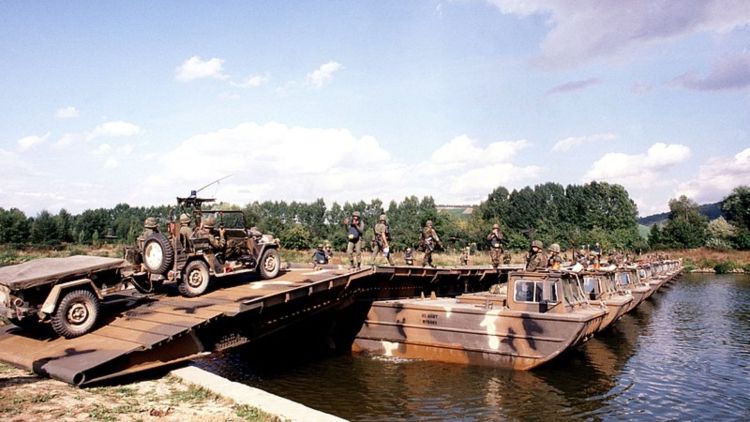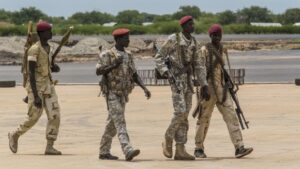Today’s SOFREP Pic of the Day takes us back in time with a #Throwback to a classic NATO military exercise that tested Cold War readiness every year until 1993. Raise your hand if you remember Reforger.
Conceived at the height of the Vietnam War, Exercise Campaign Reforger (shortened for “Return of Forces to Germany”) was formed to ensure NATO could quickly send troops to West Germany if conflict ever broke out with the Warsaw Pact. The first Reforger exercise took place in 1969, featuring a large contingent of American soldiers and strong support from Canadian and British forces.
Now is as good a time as any to make an embarrassing revelation. Up until now, I never realized that Reforger was an acronym. Be honest, did you? I just thought it was a badass made-up name to put one in mind of forging steel (or military alliances) or something like that. I should have known better; the US military can make an acronym out of anything.
In the above photo, you can see a couple of Soldiers and a vehicle passing over a fleet of M88 Mobile Floating Assault Bridge (MFAB)-F set up by the US Army 1st Engineer Battalion, 1st Infantry Division, across the Main River for Reforger 82.
The annual joint military exercise was all about planning and execution, focusing on getting everything right in case of an invasion of Western Europe—not just about showing off or deterrence.
After the Cold War ended, Reforger was replaced by other exercises, like Exercise Steadfast Defender, in which North American troops crossed the Atlantic to train with their NATO allies in Europe.
1st Engineers lay a pontoon bridge over the Main River for Blue Force vehicles during Reforger ’82, September 15, 1982. (National Archives)
Exercise Reforger: A Strategic Cold War Military Drill and Its Contemporary Relevance
Background of Reforger Exercises
As noted, Exercise Reforger, short for “Return of Forces to Germany,” was a series of annual military exercises conducted by NATO during the Cold War from 1969 to 1993. The primary purpose of these exercises was to demonstrate NATO’s ability to quickly mobilize and deploy forces to West Germany (remember when it was split) in response to a potential invasion by Warsaw Pact nations. This capability was crucial for maintaining a credible deterrent against Soviet aggression in Europe, ensuring that NATO could rapidly reinforce its European allies in a crisis without permanently stationing large numbers of troops on the continent. The exercises were designed to test the U.S. military’s logistical capabilities, including pre-positioned equipment and rapid deployment strategies. It was a huge deal at the time. Everyone, in the Army at least, seemed to block out a significant part of the year for Reforger.
Today’s SOFREP Pic of the Day takes us back in time with a #Throwback to a classic NATO military exercise that tested Cold War readiness every year until 1993. Raise your hand if you remember Reforger.
Conceived at the height of the Vietnam War, Exercise Campaign Reforger (shortened for “Return of Forces to Germany”) was formed to ensure NATO could quickly send troops to West Germany if conflict ever broke out with the Warsaw Pact. The first Reforger exercise took place in 1969, featuring a large contingent of American soldiers and strong support from Canadian and British forces.
Now is as good a time as any to make an embarrassing revelation. Up until now, I never realized that Reforger was an acronym. Be honest, did you? I just thought it was a badass made-up name to put one in mind of forging steel (or military alliances) or something like that. I should have known better; the US military can make an acronym out of anything.
In the above photo, you can see a couple of Soldiers and a vehicle passing over a fleet of M88 Mobile Floating Assault Bridge (MFAB)-F set up by the US Army 1st Engineer Battalion, 1st Infantry Division, across the Main River for Reforger 82.
The annual joint military exercise was all about planning and execution, focusing on getting everything right in case of an invasion of Western Europe—not just about showing off or deterrence.
After the Cold War ended, Reforger was replaced by other exercises, like Exercise Steadfast Defender, in which North American troops crossed the Atlantic to train with their NATO allies in Europe.
1st Engineers lay a pontoon bridge over the Main River for Blue Force vehicles during Reforger ’82, September 15, 1982. (National Archives)
Exercise Reforger: A Strategic Cold War Military Drill and Its Contemporary Relevance
Background of Reforger Exercises
As noted, Exercise Reforger, short for “Return of Forces to Germany,” was a series of annual military exercises conducted by NATO during the Cold War from 1969 to 1993. The primary purpose of these exercises was to demonstrate NATO’s ability to quickly mobilize and deploy forces to West Germany (remember when it was split) in response to a potential invasion by Warsaw Pact nations. This capability was crucial for maintaining a credible deterrent against Soviet aggression in Europe, ensuring that NATO could rapidly reinforce its European allies in a crisis without permanently stationing large numbers of troops on the continent. The exercises were designed to test the U.S. military’s logistical capabilities, including pre-positioned equipment and rapid deployment strategies. It was a huge deal at the time. Everyone, in the Army at least, seemed to block out a significant part of the year for Reforger.
Significance and Impact
Reforger was not just a show of force; it was a practical test of NATO’s strategic readiness and logistical capabilities. The exercises typically involved tens of thousands of troops, including multiple divisions, and required coordination across various military branches, including the Army, Air Force, and Navy. The ability to mobilize such a large force quickly demonstrated the commitment of the United States to the defense of Europe. It reassured European allies of U.S. support in the face of potential Soviet aggression. In those days, we were sure that the Soviet Union was going to move south through Germany and try to take Europe. We utilized concepts learned in the AirLand (not a typo) Battle doctrine, something we’ll cover on another day.
The exercises also played a critical role in improving interoperability among NATO forces. By involving troops from various NATO countries, Reforger helped to standardize procedures and improve communication and coordination between different national forces. This was vital for ensuring a cohesive and effective defense in the event of an actual conflict.
Modern Relevance and Calls for Revival
In recent years, there have been discussions about the potential revival of Reforger-style exercises, especially in light of renewed tensions with Russia. The current geopolitical climate, particularly following Russia’s annexation of Crimea in 2014 and the ongoing conflict in Ukraine, has led some military analysts and officials to advocate for a return to large-scale exercises that test NATO’s rapid deployment capabilities. These exercises could serve as a deterrent by demonstrating NATO’s readiness and commitment to defending its members against aggression.
Some experts suggest adapting the Reforger model for use in other strategic regions, such as the Indo-Pacific. This would involve large-scale exercises that test the U.S. military’s ability to rapidly deploy forces across the Pacific in response to potential threats from China or North Korea. Such exercises would help ensure that U.S. forces are prepared to operate effectively in these regions and serve as a strong signal of U.S. commitment to its allies.
Exercise Reforger was a cornerstone of NATO’s Cold War strategy, demonstrating the alliance’s ability to respond quickly and effectively to potential threats. While the geopolitical landscape has changed significantly since the end of the Cold War, the principles behind Reforger—rapid deployment, interoperability, and a credible show of force—remain relevant today. Reviving or adapting such exercises could enhance NATO’s readiness and deterrence capabilities in an increasingly uncertain global environment.
MFAB: Invaluable Asset in Modern Military Operations
The Mobile Floating Assault Bridge, or MFAB, has been a remarkable piece of military engineering since its development, acting as a crucial lifeline for modern military operations.
Floating bridges have been around for centuries, but it was the technology of the 20th century that really boosted the use of the MFABs. These bridges make it possible for ground troops to cross tough environments like rivers, lakes, and estuaries.
Thanks to their modular design, combat engineers can quickly put them together and take them apart, making it much easier to move troops and equipment where they’re needed most.
From Wooden Planks to Sturdy, Well-Engineered Mobile Hulls
Back in the day, pontoon bridges were pretty straightforward. They were made from wood, using barrels or boats tied together and anchored into place.
Wooden planks were laid across the top to create a road surface. It was a simple yet effective setup, but as you can imagine, it wasn’t always perfect.
Over the years, engineers experimented with all sorts of materials and designs. During the American Civil War, for instance, they tried using rubber and canvas to make the pontoons lighter and easier to move around—pretty creative, right?
Fast forward to World War II, and pontoon bridges really took center stage.
The US Army’s combat engineers had this down to a science. They built all kinds of bridges, like the M1938 ponton bridges and M1940 treadway bridges, which could carry different loads depending on what was needed—whether it was troops on foot or heavy vehicles.
These engineers were pros at putting these things together quickly, ensuring that troops and supplies could cross rivers in no time, even under enemy fire.
—
Disclaimer: SOFREP utilizes AI for image generation and article research. Occasionally, it’s like handing a chimpanzee the keys to your liquor cabinet. It’s not always perfect and if a mistake is made, we own up to it full stop. In a world where information comes at us in tidal waves, it is an important tool that helps us sift through the brass for live rounds.



